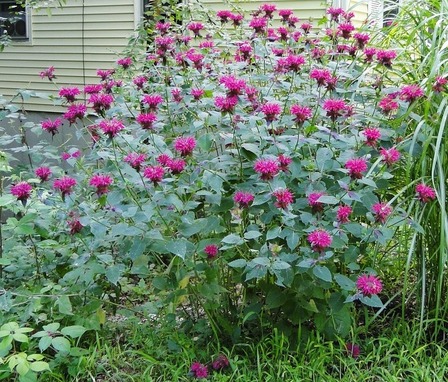|
It is used as a flavoring in cooked foods. The flowers make an attractive edible garnish in salads. The plant is noted for its fragrance, and is a source of oil of thyme. The fresh or dried leaves are brewed into a refreshing aromatic and medicinal tea.
Leaves and flowers and stems are used in alternative medicine as an antiseptic, carminative, diaphoretic, diuretic and stimulant. Bergamot’s distinctive aroma, found in both the leaf and flower is wonderful for use in potpourri. |
Bergamot
this Wild Bergamots like a rich, moist soil and, unlike the Mints
to which they are closely related, they do not succeed well in dry soil and full sun. Plant out 2 feet apart. Bergamots need careful attention to keep them free of weeds, otherwise they deteriorate rapidly. It is also advisable to split them up annually, throwing away the dead centre and planting out the younger bits in fresh soil. Two years is the longest they should be left in any one position. Propagate by rooted cuttings in the same way as Balm, any time in late summer. The monarda plant was named for the Spanish physician and botanist Dr. Nicolas Monardes of Seville Spain (DOB was 1493 – 1588) (Bremness, 1994). Monardes wrote the book Joyful News – Botany of the New World (North America). He tried to keep the new plants’ native names when “renaming” them. Interestingly, for the amount of knowledge he developed about new world plants, he never actually visited North America but had his people bring them back to his gardens in Spain. His book on North American plants was translated into English in 1577. While a fragrant herb in its own right, this Bergamot is not the source of the commonly used Bergamot Essential oil. |
- Home
- Introduction
- Choose your Plan
-
Choose your Plants
- Alecost
- Anchusa
- Angelica
- Balkan Sage
- Balm
- Basil Sweet & Bush
- Bergamot
- Borage
- Calaminth
- Camphor Plant
- Caraway
- Catmint
- Chamomile
- Chervil
- Chives
- Clary
- Comfrey
- Coriander
- Dill
- Elecampane
- Fennel
- Fennel Florence
- Feverfew
- Garlic
- Germander
- Giant Catmint
- Herb Patience
- Horehound
- Hyssop
- Lad's Love
- Lady's Maid
- Lavender
- Lily of the Valley
- Lovage
- Lungwort
- Mace
- Mallow
- Marigold
- Marjoram
- Melilot
- Mints
- Old Lady
- Parsley
- Pennyroyal
- Rose
- Rosemary
- Rue
- Sage
- Salvia Virgata Nemorosa
- Santolina Chamaecyparissus
- Savory
- Sorrel
- Sweet Cicely
- Tansy
- Tarragon
- Thyme
- Vervain
- Woad
- Wormwood
- Workshops
- Q & A
- Blog
- Contact
- Home
- Introduction
- Choose your Plan
-
Choose your Plants
- Alecost
- Anchusa
- Angelica
- Balkan Sage
- Balm
- Basil Sweet & Bush
- Bergamot
- Borage
- Calaminth
- Camphor Plant
- Caraway
- Catmint
- Chamomile
- Chervil
- Chives
- Clary
- Comfrey
- Coriander
- Dill
- Elecampane
- Fennel
- Fennel Florence
- Feverfew
- Garlic
- Germander
- Giant Catmint
- Herb Patience
- Horehound
- Hyssop
- Lad's Love
- Lady's Maid
- Lavender
- Lily of the Valley
- Lovage
- Lungwort
- Mace
- Mallow
- Marigold
- Marjoram
- Melilot
- Mints
- Old Lady
- Parsley
- Pennyroyal
- Rose
- Rosemary
- Rue
- Sage
- Salvia Virgata Nemorosa
- Santolina Chamaecyparissus
- Savory
- Sorrel
- Sweet Cicely
- Tansy
- Tarragon
- Thyme
- Vervain
- Woad
- Wormwood
- Workshops
- Q & A
- Blog
- Contact


